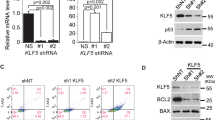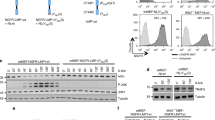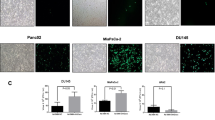Abstract
The exposure of mammalian cells to ultraviolet (u.v.) irradiation leads to activation of transcription factors, such as AP-1 and NFκB. It is postulated that the EGF receptor but not protein kinase C (PKC) is the major membrane mediator in UVC-induced signal transduction. We demonstrate here that the antisense oligonucleotides of PKCζ and the dominant negative mutant of PKCλ/ι as well as dominant negative PKCζ markedly blocked UVC-induced AP-1 activity. In contrast, UVC-induced AP-1 activity in cells devoid of the EGF receptor (B82), is not significantly different from that of the stable transfectants with a kinase-deficient EGF receptor (B82M721), or wild-type EGF receptor (B82L). This was found at all UVC irradiation doses and time courses studied, while high levels of EGF-induced AP-1 activity were observed in B82L cells but not in B82 cells. This evidence strongly suggests that atypical PKCs, but not the EGF receptor, is necessary for UVC-induced AP-1 activation in JB6 and B82 cells.
This is a preview of subscription content, access via your institution
Access options
Subscribe to this journal
Receive 50 print issues and online access
$259.00 per year
only $5.18 per issue
Buy this article
- Purchase on Springer Link
- Instant access to full article PDF
Prices may be subject to local taxes which are calculated during checkout
Similar content being viewed by others

Author information
Authors and Affiliations
Rights and permissions
About this article
Cite this article
Huang, C., Ma, Wy. & Dong, Z. Signal transduction through atypical PKCs, but not the EGF receptor, is necessary for UVC-induced AP-1 activation in immortal murine cells. Oncogene 14, 1945–1954 (1997). https://doi.org/10.1038/sj.onc.1201056
Received:
Revised:
Accepted:
Issue Date:
DOI: https://doi.org/10.1038/sj.onc.1201056


